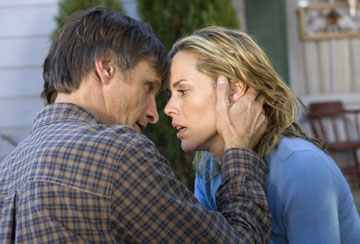
Given the very favorable (and somewhat spoilerish) reviews that David Cronenberg’s A History of Violence has been getting, I went in expecting a great film from this auteur of the disturbing (albeit one without the throbbing, fleshy, pulsating chunks of gristle usually associated with Cronenberg’s oeuvre.) But, while Violence is a good film with some excellent performances — most notably by Viggo Mortensen and Maria Bello — it is not ultimately a great one. In fact, I found it something of a letdown after all the hype. [Be warned: I don’t want to give everything away, but it’s a hard movie to talk about without delving into some very heavy spoilers, including the film’s conclusion.]
I’ve never read the source graphic novel, so I can’t vouch for the deviations in the tale, but it basically goes as follows: Viggo Mortensen is Tom Stall, a hard-working, Midwestern fella who runs the local diner in Smalltown USA. He is loved by his adoring, alluring wife (Bello, exquisite as usual), admired by his two children, respected by the community, and generally living the American dream, as long exemplified in Norman Rockwell paintings and The Saturday Evening Post. (A lot of this corn-fed small-town-America set-up — a little girl’s nightmare, a run-in with a high-school bully — comes off as completely flat and stilted, but I think there’s method in Cronenberg’s madness. What he’s doing is akin to the Naomi Watts/Nancy Drew stuff in the first half of David Lynch’s Mulholland Drive — he’s lulling us in with mundanity to knock us off-kilter later on.)
Anyway, Tom’s picture-perfect life goes awry after he becomes an unwitting “American Hero” media sensation by killing two Bad Men in his diner one evening. (We know they’re Bad Men because one of them blows away a little girl in the first five minutes, which seems like exceedingly cheap and lazy character development.) Soon, scraggly-looking n’er-do-wells like Ed Harris come-a-knockin’, convinced that Tom Stall is not Tom Stall at all, but rather…Aragorn of the Dunedain, Isildur’s Heir and a trained, lethal adversary. Ok, not quite…nevertheless, this case of mistaken identity eventually forces Stall to forego being a man of peace and come to grips with his violent tendencies. And, in true Cronenberg fashion, this violence soon seems to infect Stall’s world like a particularly dangerous viral meme, and threatens to transform forever the lives of he and his family.
Along the way, A History of Violence comments on many significant tropes in the history of violence — “justified” violence, parental violence, marital and sexual violence — culminating in a replay of the original Biblical murder (one which loses much of its force due to William Hurt being an insufferable hambone — Perhaps he and Harris should’ve switched roles.) And, to its credit, it leaves many of these setpieces tantalizingly ambiguous. Was Viggo’s kid right to smash up the bully? How should we feel about the incident on the stairwell? But, for all that, I’m with Edelstein — The larger arc of the story seems cartoonishly black-and-white. Yes, the last scene of the film is an undeniably powerful one, but, really, the Stalls get off easy. If violence, once unleashed, spreads like a wildfire, then how come only Bad People (or at the vey least Deserving People, like the bully) end up on its brunt end? True, Cronenberg shows us the gory consequences of murder (Throbbing Gristle sighting!), but never upon any character that we happen to like.
I can see the argument that the story had to end the way it did — with the Stalls perhaps physically unharmed but in spiritual turmoil — as a commentary on either the standard narrative of the Western (covered similarly in Unforgiven) or on Dubya’s foreign policy, which Cronenberg says is an analogy he and Viggo had in mind. Still, as it is, I think the story’s conclusion subverts the movie’s message. By leaving the white hats shaken, not stirred and the black hats pushing up daisies, A History of Violence ends up suggesting that violence is actually a rather effective way of dealing with Bad People, although it may cost you (sniff) a few tears. All in all, A History of Violence is a much-better-than-average movie and it’s one well worth seeing, but, in the end, I don’t think it quite holds up.


Great review. I think I will pass on this film.
too bad they did not have the depth to take the subject to another level.